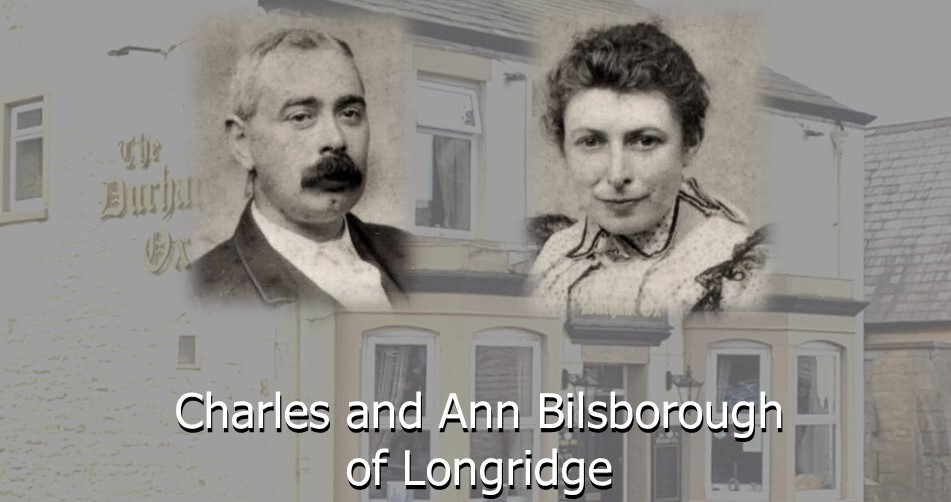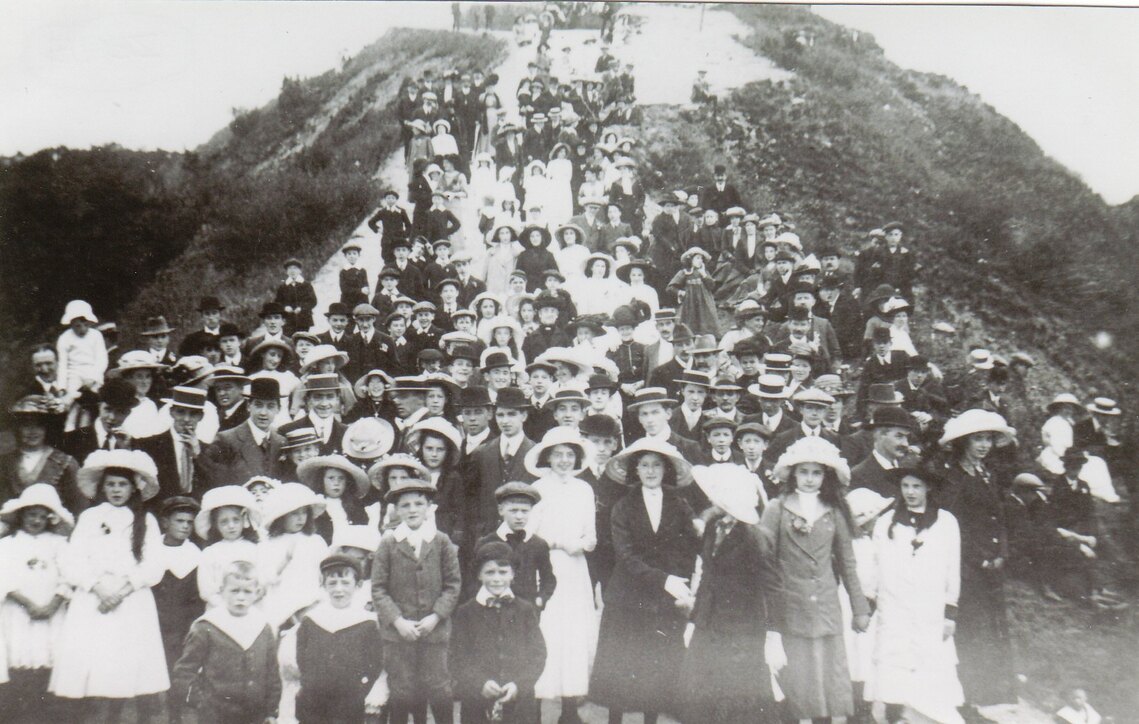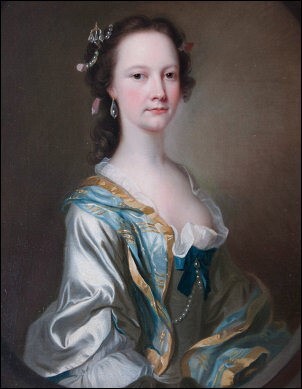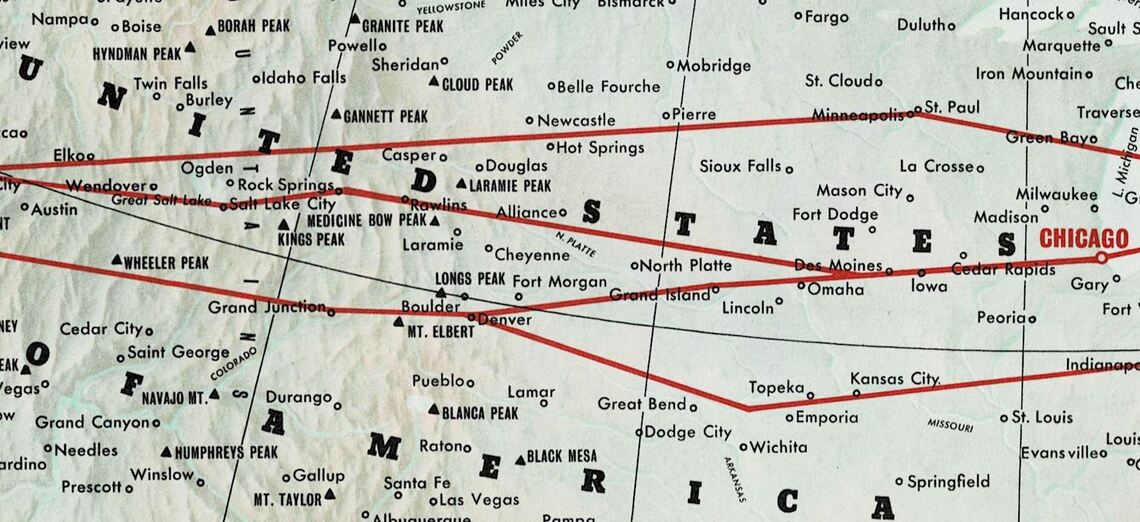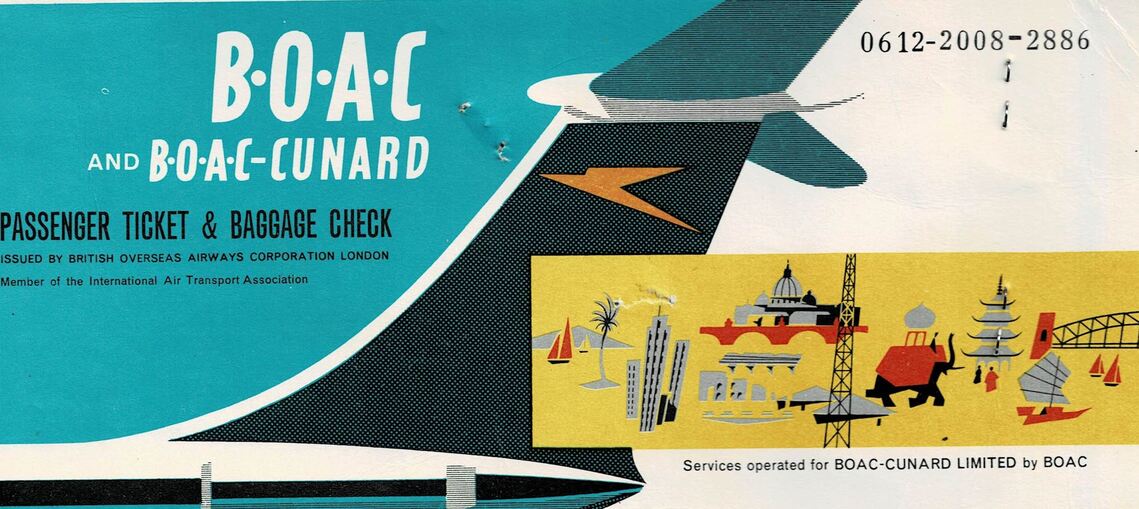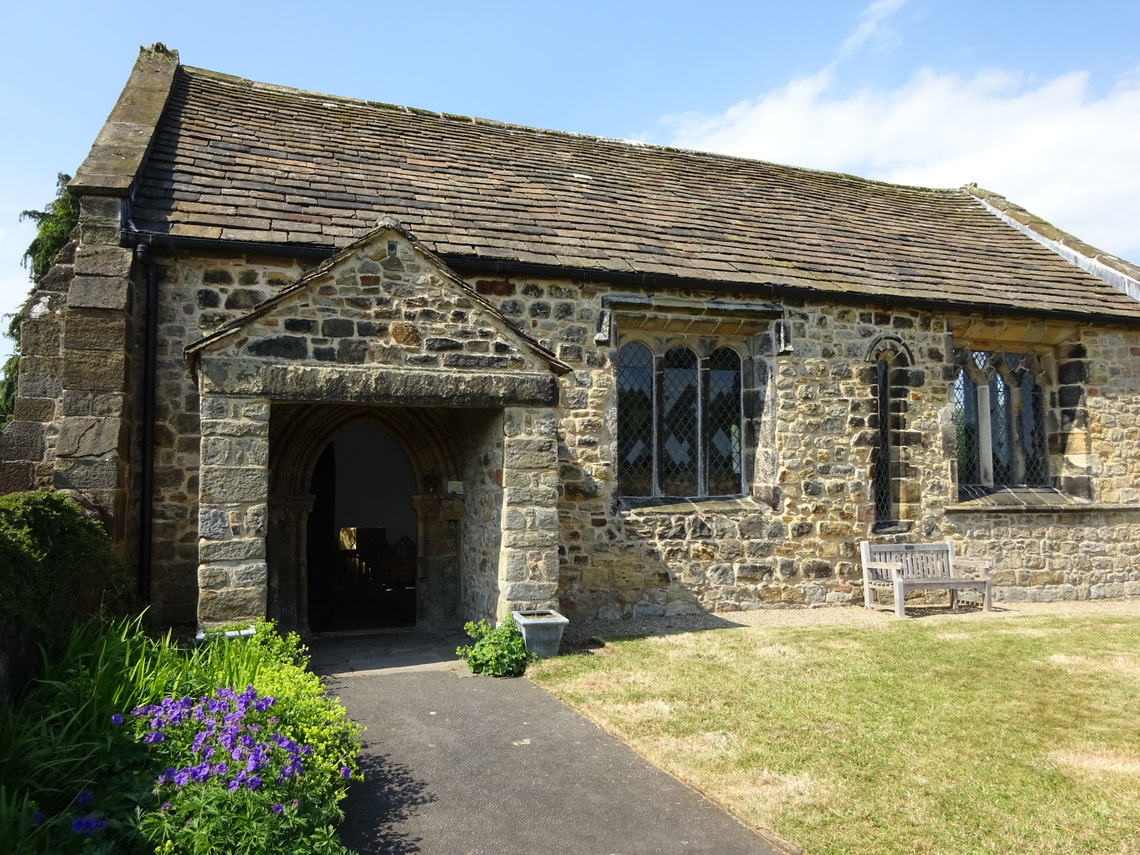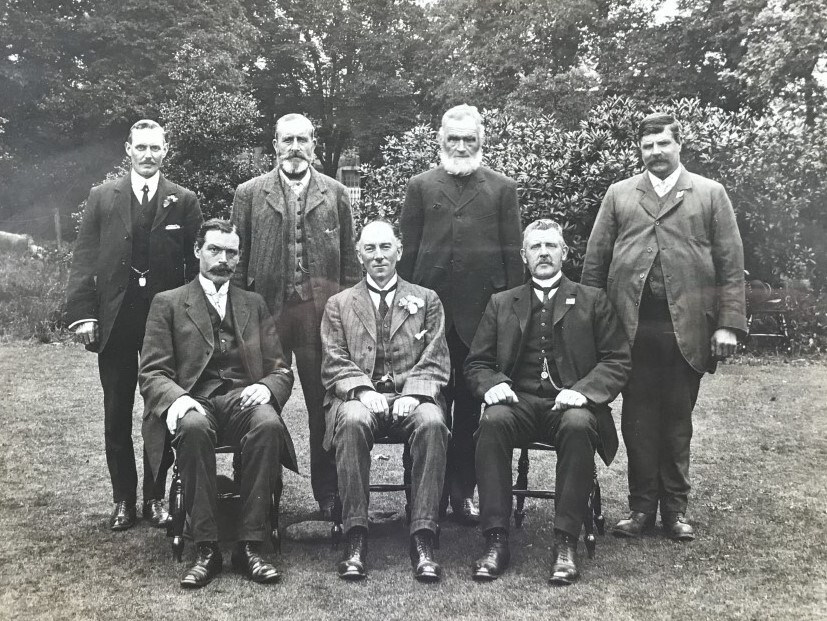|
Note: this page contains links to external websites (highlighted in blue text)
Lancashire Archives and local history: what’s in it for Longridge? Speaker: Victoria McCann 20th November 2025
Lancashire Archives Archivist, Victoria McCann, joined us in November to talk about the local history source material held in their collections at Preston. Victoria began with a short history of Lancashire Archives before describing the public, ecclesiastical and official records available to view on site including items relating to the history of Longridge. Different types of privately deposited collections were discussed in detail and illustrated with interesting examples. Victoria ended her talk with a look at the Archive’s sound and film collections. Footnote: To listen to the Thoughts from Lancashire Archives podcasts, a series of conversations about interesting items from the collections at Lancashire Archives, visit the Lancashire County Council website. (ALC)
It’s not grim up north: the history of Lancashire Life Magazine from birth in 1947 Speaker: Dr Andrew Hobbs 16th October 2025
Andrew Hobbs, former associate editor of Cheshire Life, presented an interesting talk on the development of modern English county magazines from the 1920s and the founding of Lancashire Life Magazine in 1947. The changes to Lancashire Life through the decades were explored, including the move away from articles on rural life towards aspirational lifestyle content and property advertising. Andrew ended his talk with profiles of the magazine’s notable editors, illustrators and contributors and a look at cover designs over the years. Footnote: To learn about a project to digitise early editions of Cheshire Life Magazine visit the University of Chester website. (ALC)
History of the Duchy of Lancaster Speaker: Dr Graham Kemp 18th September 2025
Graham Kemp, former Assistant Keeper at Lancaster Castle, provided the first talk of our 2025/26 programme with a fascinating account of the history of the Duchy of Lancaster. Beginning with the collection of lands known as the Honour of Lancaster, Graham described how various members of the royal family owned the lands before they were given to Edmund Crouchback, the son of Henry III, when he was created first Earl of Lancaster. The creation of the title of Duke of Lancaster in 1351 and the merger of the dukedom with the Crown in 1413 led to the Duchy of Lancaster being passed to future monarchs and providing them with financial independence from Parliament. Graham completed his talk with the ownership of Lancaster Castle by the Crown and the role of the Sheriff of Lancaster. Footnote: Did you know that the Viking silver treasure trove found on the banks of the River Ribble near Preston, known as the Cuerdale Hoard, was declared to be the property of Queen Victoria in right of her Duchy of Lancaster? The Duchy then passed it on to the British Museum in 1841 where the majority of it remains to this day. To view items from the Cuerdale Hoard visit the British Museum website. (ALC)
Extraordinary Winckley women Speaker: Steve Harrison 19th June 2025 The final talk of the 2024/25 programme was given by Steve Harrison, a member of 'Friends of Winckley Square'. Steve’s talk focussed on five fascinating women with links to Winckley Square in Preston: Lady Shelley (nee Frances Winckley), Henrietta Miller, Beatrice Todd, Ellen Chaffers and Cornelia Connelly (nee Peacock). Subjects discussed included the Horrocks and Miller families (cotton manufacturers and residents of Winckley Square), Preston High School for Girls (5 Winckley Square), the establishment of Winckley Square Convent School and the Preston Station Sailors and Soldiers Free Buffet, which provided refreshments to soldiers from 1915-1919. Footnote: The Friends of Winckley Square offer guided walks and illustrated talks to individuals and groups who are interested in learning more about the history of Preston’s only Georgian Square. To find out more visit the Friends of Winckley Square website . (ALC)
Turnpikes and maps in the North West Speaker: Paul Hindle 15th May 2025
Geographer and author Paul Hindle gave an interesting talk on the history of turnpikes which were created for the collection of tolls to pay for the maintenance of the country’s roads. Paul’s talk began with an account of how the first turnpikes, built in the 17th century, were followed by ‘turnpike mania’ between 1750 and 1772. Examples of turnpikes in the north west of England were illustrated with images from old maps, and road surfaces, drainage and footways were discussed. The second part of the talk focused on the development of detailed maps of the country’s road network which led to the creation of the Ordnance Survey. Paul completed his talk by sharing his interest in turnpikes in the Shap area. Footnote: Milestones were placed along turnpike roads to provide information to travellers about direction and distances. The Preston to Garstang Turnpike Trust erected a set of milestones in the 1700s. Nine of the milestones can still be seen today between Fulwood and Bowgreave. To learn more about the milestones and their locations visit Lancashire Past. (ALC)
Cultivating space: women’s careers in horticulture in the late 19th and early 20th century Speaker: Isabel Holt 10th April 2025
Isabel’s presentation on women in horticulture began with a look at the different styles of gardening books produced for women in the mid to late 1800s. This included gardening books for the ‘New Woman’ (educated, independent career women) and the professional female gardener. The gender divide between the professional, masculine, gardener and the amateur, feminine gardener was explored along with the rise of women gardeners creating spaces for themselves in the form of cottage gardens. Isabel concluded her presentation with the creation of private gardening schools for women in the first half of the 20th century and the struggles faced by women gardeners when seeking employment. Footnote: Fanny Wilkinson, Britain’s first professional female landscape gardener, was born in the Manchester suburb of Greenheys in 1855. To read about the life and career of Fanny Wilkinson visit the English Heritage website. (ALC)
Gawthorpe Hall Speaker: Clive Spencer 20th March 2025
Gawthorpe Hall volunteer, Clive Spencer, gave the talk for March. Clive began with an account of the Shuttleworth family who occupied the site from the 14th century. The building of the Elizabethan/Jacobean mansion in the early 1600s and its redesign by Charles Barry in the middle of the 19th century was described including interesting details about the hall’s plasterwork and minstrel gallery. The second part of the talk focussed on the life of Sir James Phillips Kay-Shuttleworth including his work as a politician and educationalist and his friendship with Charlotte Bronte who visited the hall in 1850. Clive ended his talk with Rachel Kay-Shuttleworth’s occupation of the hall which became the home of her large textile collection. Both the hall and the textile collection being cared for by the National Trust and Lancashire County Council after her death. Footnote: The Gawthorpe Hall collection, including architectural drawings by Charles Barry, can be viewed on the National Trust Collections website. To learn more about the Gawthorpe Textiles Collection visit the museum website. (ALC)
The Local Friendly Societies of Longridge (1780 - 1835) Speaker: Dr Chris Topping 20th February 2025
February’s talk was delivered by Dr. Chris Topping, who shared his in-depth knowledge and enthusiasm for the Friendly Society movement in the 18th and 19th centuries. Chris began his talk with an explanation of the difference between affiliated and local friendly societies. He also outlined the financial support that members at both levels could expect to receive in times of injury, sickness, and death. Some friendly societies even helped with funeral costs and provided members with a pension scheme. In order to manage their financial risk, friendly societies did not cover unemployment and underemployment. During the course of Chris’s research, he has uncovered some fascinating data concerning friendly societies in Lancashire and Longridge and its townships. Chris shared maps and tables to illustrate the growth of friendly societies in Lancashire, the number of friendly societies in Longridge and local townships, and membership by gender and occupation. Chris has also discovered material regarding the legal registration of friendly societies, contribution amounts, their membership rules, membership fines and reasons for expulsion, officers’ duties, and meeting locations. Chris concluded his talk by explaining the reasons for the significant decline of friendly societies in the 1940s. This was primarily due to sweeping national social reform and the introduction of the National Insurance system and the NHS, eliminating the need for self-help societies even though some friendly societies still exist today. Footnote: The Wellcome Collection website contains an illustrated article on the friendly societies and healthcare . (KM)
An Evening with Edith Rigby, Preston's most famous suffragette Speaker: Judy Beeston 6th February 2025 – Annual Dinner
Judy Beeston, Friend of Winckley Square, provided an entertaining and informative talk for the Society’s annual dinner. Judy took on the persona of Edith Rigby to portray her life as a suffragette, her marriage to Charles Rigby and her work as a social activist to improve the lives of women. Edith’s activities in Preston, including improving the working conditions of women who worked in factories and providing educational facilities for girls were described, followed by an account of her activism as a suffragette which led to imprisonment and force feeding. Edith Rigby’s independent spirit and her unconventional approach to life as middle class woman in Victorian and Edwardian Preston was illustrated throughout the talk. Footnote: To read more about the life of Edith Rigby visit the Winckley Square website . (ALC)
Tenters in the landscape, a remarkable history Speaker: Dr Graham Cooper 16th January 2025
Graham began his illustrated presentation with an overview of the complex production of woollen cloth focusing on the 18th and 19th century practices. The woollen cloth industry provided a good source of employment and brought economic wealth to Great Britain. However, it was subject to a number of fraudulent practices and abuse bringing the industry into disrepute both here and abroad. Before expanding on the industry wide abuse, Graham explained about one of the processes particularly abused for financial gain - the tentering process. This involved woollen cloth being stretched and dried on outdoor frames - tenters. Graham showed examples of tenters, or evidence of where tenters had been located, that have been recorded in Exeter, Lancashire, Northumberland and West Yorkshire. Now moving on to the nature of the industry wide abuse, Graham elaborated on the common practice of over stretching the woollen cloth during the tentering process. This practice caused the finished cloth to shrink on the first exposure to water/rain. To combat this, regulations stipulated that tentering had to be conducted outside, so that the process could be monitored more easily by the authorities. This requirement subjected the woollen cloth to all types of weather conditions, tampering and theft and subsequently interfered with the fulfilment of orders and timely exports. In the final section of Graham’s presentation he expanded on how Parliamentary statutes were established to improve quality, protect the economic benefits and reputation of the woollen cloth-making industry. Graham’s research has also uncovered fascinating crime data and punishments connected to tenter interference, cloth larceny, burglary, robbery and capital offenses. Footnote: For more information on this subject please visit Graham’s website: www.tenters.org (KM)
'Brilliantly Brutal, a new look at Preston Bus Station' Speaker: Michael Akers 12th December 2024
Michael Akers, Friend of Winckley Square and local historian, set the scene by taking the audience back to the 1960's before describing the who, what, when, where, why and how of this iconic piece of Brutalist architecture: Preston Bus Station. With a wide selection of photographs and illustrations Mike was able to demonstrate: (1) the concept behind the Central Lancashire Development Corporation transport plan; (2) the groundbreaking design and methods utilized to build the bus station; and (3) uncover the bespoke nature and durability of the interior design elements - all of which are still in use and visible today. In the final part of the presentation, Mike described the decline of the building and the subsequent battle to save it from demolition. English Heritage granted the station Grade II listed status 23rd September 2013. Footnote: During the year Mike leads organized walks focussing on Preston Bus Station and the buildings which surround it. (KM)
The Great Scottish Raids, 1315-1322 Speaker: Dr Chris Tinmouth 21st November 2024
Dr Tinmouth’s talk began with the Anglo-Scottish War of 1296 when the Scottish King John Balliol’s treaty with France led to the invasion of Scotland by Edward I. Defeats by the English army and the use of guerrilla warfare in the fight for Scottish independence by Robert the Bruce were described. Chris discussed how the north of England was exposed to Scottish raids after the Battle of Bannockburn culminating in the Great Raid of 1322 which resulted in the destruction of property and the capture of livestock in Samlesbury and the Forest of Bowland. In his conclusion Chris stated that the lasting material and psychological damage of the raids shaped the attitude of the English towards the Scots and contributed to the creation of a sense of self for the people of northern England. Footnote: On 14th October 1322 Edward II's army was defeated by Scottish forces commanded by Robert the Bruce at the Battle of Byland in Yorkshire. To learn more about the Battle of Byland visit the Battlefields Trust website . (ALC)
The oldest museum in the English-speaking world: Stonyhurst College Speaker: Dr Jan Graffius 17th October 2024
The talk for October was given by Dr Jan Graffius, Curator of the Stonyhurst College historic collections, archives and museum. Jan explained how the original library collection held at the College of St Omers in France was saved when the school moved to England in 1794 and rebuilt in the form of The Arundell Library, The Bay Library and The Square Library. A small museum was opened in 2017. Jan described the objects, relics, books, artworks and manuscripts that are displayed and cared for at Stonyhurst for the benefit of pupils, researchers and visitors. Footnote: A timeline for the history of the colleges of St Omers and Stonyhurst can be viewed on the Stonyhurst College website . (ALC)
The drowning of Mardale by Haweswater Speaker: Ian Tyler 19th September 2024 Mining historian and author Ian Tyler provided the first talk of our 2024/25 programme. Ian began with a history and description of the small Lake District village of Mardale Green. The working and social lives of this once thriving community were discussed and illustrated with a selection of photographs. The second part of the talk focussed on the flooding of the village to create the Haweswater Reservoir including the building of the dam and the creation of a large encampment for the workers. Ian shared interesting photographs of the remains of the village which were recently exposed during a drought. He concluded his talk by describing the area as a “beautiful valley full of mystery”. Footnote: Further information about the 72-mile aqueduct from Haweswater to Heaton Park reservoir in Manchester, including the Bowland Forest tunnel, can be found on the Tatham History Society website. (ALC)
The history of Longridge Gas Company Speaker: John Spencer 20th June 2024 The final talk of the society’s 2023/24 programme began with a brief history of the use of coal gas for street lighting. Mr Spencer described the establishment of the Longridge Gas Company in 1854 and the building of the town’s gas works on Gas Street. The introduction of gas lamps in Longridge, the employment of a gas lamp lighter and the employees of the gas company were discussed in detail. John provided an account of the events leading up to the boiler explosion at the gas works on 28th September 1905 which resulted in the deaths of two men. The talk concluded with newspaper reports of the explosion and the results of the enquiry that followed. Footnote: A brief history of the introduction of gas lighting in Britain can be found on the Age of Revolution website which was created to support the commemoration of the bicentenary of the Battle of Waterloo. (ALC)
“Longridge in the time of my great grandparents, Charles and Ann Bilsborough” Speaker: Peter Towers 16th May 2024 Peter’s talk focussed on the lives of Charles Bilsborough, who was landlord of the Durham Ox public house in Longridge from 1896 to 1915, and his wife Ann. Sources used to research family history including the census, local newspapers and family photographs were discussed. The importance of local research including visiting the places inhabited by family members and finding connections with those who resided and worked alongside our ancestors was also highlighted. The story of Charles and Ann’s lives as told by Peter provided interesting glimpses into life in Longridge in the late eighteenth and early nineteenth centuries including the local council, the Longridge and District Pigeon Homing Society, Longridge Band and the Victoria Street Bobbin Mill. Footnote: To view photographs of Longridge pubs and clubs, including those collected by members of the History Society, visit the Longridge Heritage Centre Trust Image Archive (ALC)
The unsatisfactory reports concerning Mrs Parkinson: the St Annes Lifeboat Disaster Fund, the “Mexico” Lifeboat Monument and Victorian charity Speaker: Andrew Walmsley 18th April 2024 Andrew began his talk with a brief history of St Annes during the Victorian era. He then went on to describe the background to the lifeboat disaster in 1886 which led to the building of the “Mexico” Lifeboat Monument in 1888. The newspaper articles, poems and ballads written about the disaster were also discussed as were the use of the memorial’s image on postcards, souvenirs and even the masthead of the local newspaper. Thomas Parkinson, whose name appears on the monument, was a member of the St Annes lifeboat crew and Andrew spoke about the allowance paid to his widow Mary and her children by the Southport and St Annes Lifeboat Disaster Fund. He then discussed the conditions that were placed on recipients of the allowance by the Fund’s Committee and the power that they had to withdraw payments if recipients neglected themselves or their children. Andrew concluded his talk by observing that Victorian charities such as the Lifeboat Disaster Fund set terms that must be met but were not always able to help those receiving charity to reform their lives. Footnote: To learn more about the Southport and St Annes lifeboat disaster visit the RNLI website (ALC)
Mediaeval Bridges of the Ribble Valley Speaker: Chris Hudson 21st March 2024 Chris Hudson used his background as a Senior Design Engineer for his talk on bridges built in the Ribble Valley from the fifth to the fifteenth centuries. Chris began his talk by summarising the sources he used to research the history of bridges in the local area including the Gough map of 1360 and John Speed’s map of 1610. The early history of river crossings from the Bronze Age to the time of the Romans was discussed. Chris also described the medieval stepping stones crossing the River Ribble at Brungerley near Clitheroe and the dramatic capture of King Henry VI near to the stones in 1465. Chris examined the design, building, alteration and maintenance of medieval bridges using Edisford Bridge, West Bradford Bridge, Cromwell Bridge, Whalley Bridge and Paythorne Bridge as examples. He ended his talk by encouraging us to look closely at bridges - both from above and below. Footnote: To read more about bridges in Lancashire visit Lancashire Past a Lancashire history website and blog written by former school teacher Adrian Bowden. (ALC)
Frogs, firearms and flames: unexpected hazards in museum collections Speaker: Heather Davis 15th February 2024 The talk for February was given by Heather Davis, Conservation Manager for Lancashire County Museum Service. Heather explained about hazardous substances found in everyday objects dating from the late 19th and early 20th centuries including asbestos, radiation and uranium. More unusual items that museums have to handle with care were also described such as poison darts, taxidermy and explosives. Heather discussed the methods used to protect museum staff and members of the public from hazardous items. Footnote: The Conservation and Collections Team from Lancashire County Council’s Museum Service have produced a blog showcasing stories about objects held in their collections. To view ‘Lancashire Museum Stories’ click here (ALC)
John Balshaw’s jigge: revelry and royalism in Restoration Lancashire Speaker: Dr Jenni Hyde, Lancaster University 1st February 2024 – Annual Dinner The subject of the Society’s annual dinner was the only known stage ‘jig’ composed in the North West of England. Written in Brindle in the 1660s this short dramatic piece in verse would have been sung to popular tunes of the day. Dr Hyde described how she came across the manuscript of the jig when researching ballads at the British Library. Written around the time of the Restoration of the Monarchy, the jig focussed on the time of the English Civil War. Jenni discussed how she studied the manuscript for evidence of local attitudes to the Civil War and carried out research into the Balshaw family living in the Brindle area at this time. After editing the manuscript for publication by the Regional Heritage Centre Jenni set the jig to popular ballads from the seventeenth century and took part in the first performance of the jig for 350 years at Brindle. Jenni sang extracts from ballads during the talk much to the enjoyment of the audience. Footnote: The Regional Heritage Centre at Lancaster University was established in 2014 to promote and celebrate the social and cultural heritage of North West England. The Elizabeth Roberts Working Class Oral History Archive is hosted on the Regional Heritage Centre website. It contains transcripts of interviews capturing memories of working-class life in Barrow-in-Furness, Lancaster and Preston. To view the archive click here (ALC)
My work as a local history detective Speaker: Steve Halliwell 18th January 2024 Steve’s talk focussed on how he became an amateur local historian and what he has found out over the past 25 years. An interest in the history of Preston included research into the life of Moses Holden who taught astronomy and was a founder of The Institute for the Diffusion of Knowledge (now UCLan). Steve described how he identified a photograph of Moses Holden and wrote the book ‘Moses Holden 1777-1864: the Preston astronomer who was never eclipsed’. Steve completed his talk by sharing his tips for carrying out local and family history research. Footnote: Further information on the history of astronomy in Preston, including Jeremiah Horrocks, Moses Holden, George James Gibbs and the Deepdale, Moor Park and Alston observatories can be found on the Jeremiah Horrocks Institute website (ALC)
England’s most unusual and enigmatic railway: the Whittingham Hospital line Speaker: David J. Hindle 14th December 2023 Mr Hindle’s latest talk began with the building of Whittingham Hospital, its opening in 1873 and its growth to become the largest psychiatric hospital in Britain. The layout of the hospital and its grounds were described and illustrated with interesting photographs. David explained how coal and other goods were brought to the hospital by horse until a two mile private branch line to Grimsargh was built in 1887. The route of the line and the four locomotives that ran on it until its closure in 1957 were discussed in detail. David also included stories about the free transport provided for hospital staff and passengers and a description of the line’s ornate, glass-roofed, station building. Footnote: This photograph shows Whittingham Asylum locomotive ‘No. 2’. To view other photographs of the hospital and its railway, including those collected by members of the History Society, visit the Longridge Heritage Centre Trust Image Archive (ALC)
5 Winckley Square – ‘a house through time’ part 2 Speaker: Susan Douglass 16th November 2023 The second of Susan’s talks about 5 Winckley Square began with the death of its original owner, Thomas Miller, in 1865. Thomas had been the proprietor of the Preston textile company Horrocks, Miller and Co. and left his considerable fortune to his five children. Susan described the life of Thomas’ eldest daughter Henrietta Mary who returned to live at 5 Winckley Square in the 1880s after the end of her marriage. The second part of the talk was on the lease of the house by Preston High School for Girls in the early 1900s and the interesting life of the building’s caretaker, a retired policeman from Bradford. Susan then focussed on two Preston headmistresses, Alice Mary Stephenson of Preston High School for Girls and Alice Mary Stoneman of the Park School who inhabited the house until 1930. The last part of Susan’s talk covered the war years when evacuees lived at the house, its use as a sixth form and catering college in the 1960s and 1970s and its purchase by developers. Susan also reflected on the fact that the house’s original features have been retained throughout its history. Footnote You can learn more about the buildings, people and stories of Winckley Square by visiting the Winckley Square Gardens website (ALC)
Roughs and respectables: the pleasures and problems of leisure in Victorian North West Speaker: Dr Michael Winstanley 19th October 2023 Dr Winstanley has studied and classified leisure during the Victorian era and his talk compared professional forms of entertainment with amateur recreational activities. Michael led us through local customs and festivals celebrated in the nineteenth century and described how the introduction of cheap rail travel allowed working people to enjoy day trips and holidays to the coast. Sporting activities of the working and upper classes were compared and the restrictions and rules that the authorities attempted to apply to combat sports were defined. Michael discussed how the popularity of pubs and beerhouses and the resulting social problems led to the creation of the temperance movement. The talk was rounded off with a description of working class entertainments such as travelling shows and music halls and the more respectable forms of leisure to be found in the theatre and tightly controlled and regulated Victorian parks. Footnote:
This photograph, dating from the early 1900s, shows a group of people in their ‘Sunday best’ enjoying the views from the Broad Walk at Tootle Heights Park, Longridge. To see other photographs on the subject of sports and recreation in Longridge, including those collected by members of the History Society, visit the Longridge Heritage Centre Trust Image Archive (ALC)
Browsholme Hall and the archive of the Parker family Speaker: Anna Watson 21st September 2023
The first talk of the society’s 2023/24 programme was by archivist Anna Watson. Anna described her work cataloguing the archives of Browsholme Hall which was built in 1507 and is the ancestral home of the Parker family. Although much of the Parker family archives are held at Lancashire Archives there is a sizeable amount of correspondence held at the hall as well as some deeds, photographs and diaries. During her talk Anna highlighted some interesting items from the archive including the diaries of 18th century gentlewoman Elizabeth Shackleton (born Elizabeth Parker) and the account book of Edward Parker which dates from the Civil War. Anna discussed how the archive is a valuable source of both local and social history and how it has been used to research the lives of the Parker family.
Elizabeth Shackleton (1726-1781) Footnote: Preston-born historian Amanda Vickery based her first book, “The gentleman’s daughter: women’s lives in Georgian England”, on the writings of Elizabeth Shackleton. To listen to the Oxford Dictionary of National Biography entry for Elizabeth Shackleton click here (ALC)
Rufford Old Hall Speaker: Margaret Lambert 15th June 2023
The final talk of the society’s 2022/23 programme was on the Hesketh family of Martholme and Rufford. Margaret described the design and building of Rufford Old Hall by the Heskeths in the 1500s and how it developed over the next three centuries. The changes in the fortunes of the Hesketh family and their home was explored, ending with the donation of Rufford Old Hall to the National Trust in 1936. Footnote: The Historic England website contains entries for listed buildings in the Longridge area including the Grade II listed Alston Old Hall. (ALC)
Lancaster and the Transatlantic Slave Trade Speaker: Dr Nick Radburn, Lancaster University 18th May 2023
The subject of this talk was the role of the port of Lancaster in the transportation and trade of enslaved Africans in the 18th century. Dr Radburn explained why Lancaster became involved in the slave trade, the families behind it, and its impact on the local area. The shipping of goods from Lancaster to Africa was detailed as were the horrific conditions endured by captive Africans during their transportation to the Americas. The return journey carried goods such as tobacco and sugar which were produced by slave labour from the Americas to Lancaster. Footnote: In February 1853 the abolitionist lecturer Henry Box Brown exhibited his ‘American panorama of slavery’ at the Exchange Rooms in Preston. Henry, who was born on a plantation in Virginia, escaped slavery when he climbed into a wooden box and mailed himself to the Philadelphia antislavery office in 1849. When the 1850 Fugitive Slave Act was passed and escaped slaves in free states were required to be returned to their owners Henry fled to England and settled in Manchester. (ALC)
Unsung Lancastrians Speaker: Steve Williams 20th April 2023
In this talk we learnt little known facts about a number of interesting men and women from Lancashire. Subjects included sport, arts and entertainment, World War Two, charity work, law and order, politics and industry. Steve also included stories about his family and shared his tips on researching family history. Footnote: “A history of Longridge and district” by Tom C. Smith, which was published in 1888, contains a chapter on local celebrities. The following extract relates to James Tullis of stonemasons Cooper and Tullis, builders of many of the large buildings in Preston including St Walburge’s Church, St Mark’s Church, Preston Town Hall, Preston Railway Station, Harris Free Library and Whittingham Hospital. “Mr. James Tullis, a member of the firm of Cooper & Tullis, has been the main stay and support of the Independent Church of Longridge since its establishment. His good deeds are not confined to helping on one denomination only. He is always ready (as is his wife), to give a helping hand to any good cause, or any deserving, and sometimes undeserving, people in distress … Mr. Tullis came to Preston in 1834, having been born at Cupar, Fife, in 1824. His firm soon became known as a first-class one in the stone and building trade. Mention has been made of several of the leading works they have successfully carried out. Mr. Tullis lives a quiet, retired life, but is always willing to do what he can to promote the prosperity of Longridge.” Copies of “A history of Longridge and district” by Tom C. Smith can be viewed at Longridge Library. (ALC)
A manicurist in cowboy country: the remarkable adventures of Edith Alice Crosby, 1882-1968 Speaker: Dr Alan Crosby 16th March 2023
In the third of his series of talks about his family history Dr Alan Crosby described how he used online sources to piece together the life of his great aunt Edith Alice Crosby who migrated from the south of England to the small town of Casper, Wyoming, in the early 1900s. The US census and local newspapers provided information about Edith’s time working as a manicurist and the training she undertook to qualify as a hospital nurse. Alan also discovered that Edith moved to Los Angeles where she met and married her husband and adopted two sons. By searching various online sources including World War One and World War Two draft cards, obituaries and even San Quentin Prison records, Alan found further glimpses into the lives of Edith and her family. Dr Crosby concluded that although many key records in the United States have been digitised some are currently only available by paying a subscription. Footnote: Getting there … and back In the early 1800s sailing across the Atlantic to America took at least six weeks which would have made it difficult for emigrants to ever return home again. By the end of the century faster and cheaper steamship passages made visiting family and friends a possibility. Although it was expensive, air transportation became more accessible in the 1950s and the transatlantic crossing could now be made in hours rather than weeks. Map showing the British Overseas Airways Corporation (BOAC) route crossing the USA in the 1960s. The town of Casper is above the 'D' of 'United States'. BOAC ticket used by a member of Longridge History Society who travelled from Lancashire to Canada in 1965 to visit relatives who emigrated there in the 1950s.
For further information on locating records of emigration and emigrants visit the National Archives website (ALC)
Thomas Cromwell, ballads and the Pilgrimage of Grace Speaker: Dr Jenni Hyde, Lancaster University 16th February 2023
Dr Hyde’s talk focused on ballads sung at the time of the Pilgrimage of Grace. She explained how songs critical of Henry VIII’s chief minister, Thomas Cromwell, posed such a threat to the regime that they were collected and monitored by the government in London. Jenni described how the words of popular ballads were changed to reflect religious and economic grievances caused by the dissolution of the monasteries. Ballads were an important way of spreading information at a time when people could not read and the emotional impact of crowds singing popular songs together was used to recruit them to the rebel cause. Jenni sang extracts of ballads throughout the talk and spoke in detail about “The Sawley Ballad” and “An Exhortation to the Nobles and Commons of the North”, the only complete songs to have survived from the Pilgrimage of Grace. Dr Hyde’s recordings of ballads, including the original version of “The Hunt is Up” which was reworded and sung by the rebels, can be found on the Soundcloud website Footnote: In October 1536 there was a rebellion in Lincolnshire against the religious and economic policies of Henry VIII. After a fortnight the rebellion was suppressed but a second revolt led by Yorkshire-born lawyer Richard Aske began later the same month. The revolt spread to Cumberland, Northumberland and north Lancashire and in December 1536 the rebels formed a council in Pontefract. They demanded the re-establishment of the Catholic Church and parliamentary freedom from royal influence. Thomas Howard, 3rd Duke of Norfolk and uncle of Anne Boleyn, negotiated with the rebels on behalf of the king and offered them a full pardon. Richard Aske dispersed his followers but a number of smaller riots were suppressed by the government and the leaders of the rebellion, including Aske, were executed. The Pilgrimage of Grace in Lancashire Sawley Abbey was one of the smaller abbeys that Henry VIII ordered to be suppressed in 1536. A group of locals helped the monks to return to the abbey and asked the leaders of the rebellion for aid. Sir Nicholas Tempest, Bowbearer of the Forest of Bowland, travelled to Whalley Abbey with four hundred men to persuade the monks and their abbot John Paslew to swear their allegiance to the rebel cause. It is not known how far Abbot Paslew became involved in the rebellion but he was found guilty of High Treason and executed at Lancaster on 10th March 1537. The abbey at Whalley was closed the same year. (ALC)
Life in 14th Century England Speaker: Linda Sawley 2nd February 2023 – Annual Dinner
East Lancashire author Linda Sawley gave the talk at the Society’s annual dinner. The subject of the talk was a day in the life of a person living in fourteenth century England. Linda began by outlining the social structure of medieval England before describing the daily routines of ablutions and dressing, meals, work, leisure and preparations for bedtime. Linda provided interesting insights into the lives of men and women of different social classes including finances, religion and marriage. Using her background in nursing Linda explored medieval ideas about health and wellbeing which were based on the theory of the four humors. Footnote: Before the establishment of St Lawrence’s Church in the early 1500s the area that we now know as Longridge consisted of agricultural settlements located within the ancient townships of Alston and Dilworth. In the fourteenth century Thomas de Hothersall held the manor of Alston with Hothersall and in the 1350s it was recorded that the tenants of Dilworth and the neighbouring township of Ribchester were involved in a number of disputes relating to waste lands and common rights. The hospital of St. Saviour at Stydd in the parish of Ribchester provided shelter for pilgrims and may have cared for people suffering from leprosy until the middle of the century. In the early 1300s John de Knoll held land in the nearby township of Thornley with Wheatley as part of a knight’s fee before acquiring two dwellings and a further two oxgangs (about thirty acres) of land. In 1322 the local area suffered raids carried out by Scots led by Robert the Bruce. Repeated famines between 1315 and 1317 weakened the people and the arrival of the Black Death in 1346 led to the loss of at least a third of the population. Land owners such as the Knoll family at Thornley may have found it difficult to find labourers to work on their land and wages would have had to be increased. Church of St Saviour at Stydd (12th century with later additions) (ALC)
The Openshaw family at Hothersall Hall, from 1850-1950 Speaker: Sir Peter Openshaw 19th January 2023
Hothersall Hall was the residence of the Hothersall family from the Middle Ages to the 18th century. The family remained loyal to the Catholic Church after the English Reformation and were fined for recusancy. Brothers John and George Hothersall died while fighting for the Royalist army during the English Civil War. A later John Hothersall took part in the Jacobite rising of 1715 and was captured during the battle of Preston. After escaping he lived secretly with his sister Anne Leckonby at Great Eccleston. Hothersall Hall and Manor passed to the descendants of Anne Leckonby before being sold to Jonathan Openshaw, a Bury woollen mill owner, in 1852. As it was now derelict, Jonathan Openshaw took the decision to pull down the original hall and build a new home in the gothic style. The present Hothersall Hall, which was completed in 1856, includes the original gate piers and a carved stone containing the arms of Hothersall together with the initials T.H. and the date 1695. Further purchases included the Alston Estate from Lord Derby, cottages at Chapel Hill, Longridge, and the provision of land for the churchyard at Ribchester. When Jonathan Openshaw died in 1882 a fountain was erected in his memory at Dilworth Lane/Lower Lane in Longridge. Jonathan’s nephew, Frederick Openshaw, inherited the estate and after his death in 1912 Hothersall passed to his son Sir James Openshaw. Sir James studied Law at Cambridge and was Chair of the Preston Quarter Sessions. When Sir James died in 1935 the estate was divided between his three children and the hall was let out to tenants before being sold. Sir Peter Openshaw, grandson of Sir James, provided an interesting account of the Openshaw family’s time at Hothersall Hall. He described Jonathan Openshaw as a good neighbour who was frugal, supported charities and showed horses at the Longridge Agricultural Society show, of which he was President. The audience was interested to hear about the photographs of local residents that Jonathan commissioned and the detailed instructions that he left for his nephew relating to the estates, staff and farm tenants. Sir Peter read out extracts from his grandfather’s game book including wildlife observations and talked about his memories of his grandmother and her donation of land for the creation of Hothersall Lodge Outdoor Education Centre. The Openshaw family’s work to improve the land on their estate, their interest in the development of agricultural practices and their concern for their farm tenants was detailed. Sir Peter also discussed how in later years, the effects of the Great War, the stock market crash of 1929 and the resulting agricultural depression led to the tenants’ inability to pay commercial rents. The family were reluctant to reorganise the farms as this would have been unkind to the tenants and the estate became no longer profitable.
Carved stone at Hothersall Hall dated 1695
Following the talk by Sir Peter Openshaw we have been sent a photograph by the great granddaughter of John Procter who was farm bailiff at Hothersall Hall. John Procter is standing on the back row third from the left. Sir James Openshaw is seated in the centre of the front row. Does anyone recognise any of the other people in the photograph? Were they estate workers? It is estimated that the photograph was taken in the 1920s. If you can help please contact us at longridgehistory@outlook.com
|

